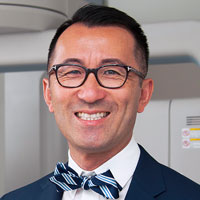The assessment of any imaging examination relies on a familiarity with the normal anatomy contained therein. Although students develop competency with the classic radiologic appearances of normal anatomy in dental school, it is only after seeing hundreds, if not thousands of images that the practitioner develops an appreciation for the range of these normal appearances. Even so, normal anatomy may be presented on panoramic images that may be confused with a disease or disease process. This lecture will provide a systematic approach to the investigation of panoramic images, and explore the range of normal appearances that may be misinterpreted as disease.
Learning Objectives:
- To develop a systematic approach to panoramic image investigation.
- To understand the range of what may be considered normal anatomy on panoramic images.
- To identify key areas on the panoramic image where normal anatomy may be confused with disease.

